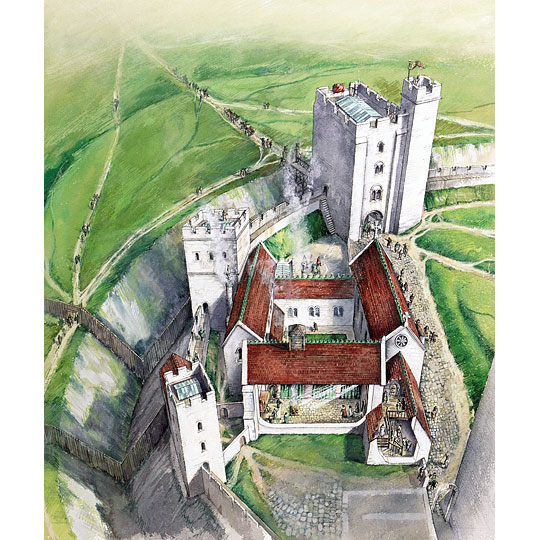Research on Old Sarum
Current understanding of Old Sarum is extremely patchy, both historically and archaeologically. There is considerable potential for further research.

Excavations at Old Sarum
The excavations which took place in 1909–15 were abandoned before the cathedral precinct had been fully investigated, and the death of the director of the excavations, William St John Hope, in 1919 meant that a final report was never written. These excavations are ripe for reappraisal, and it is hoped that a provisional reassessment may be published within the next two years.
Most recent work has concentrated on the areas outside the ramparts, as a consensus has grown that the main centres of population in the Roman and medieval periods were outside the old fort.[1]
Current Knowledge
For the medieval phases, a valuable survey of what is known of the castle was published in The History of the King's Works,[2] and reconstruction drawings of the courtyard house have been undertaken for English Heritage.[3]
The architecture of the late 11th-century cathedral has been the subject of an important article by Richard Gem in 1990.[4] However, our grasp of the overall dispositions of the 12th-century cathedral remains rudimentary, and is compromised by the ambivalent archaeology of the east end.
Most work on the 12th-century cathedral has therefore concentrated on its architectural sculpture, and a cluster of informative articles has been published since 1970.[5] The 2012 publication of a catalogue of the Old Sarum stonework at the Salisbury Museum is a significant addition.[6]
Historically, much research was done in the 19th century on the history and liturgy of Old Sarum Cathedral,[7] and more recently on the establishment of a prebendal system, the identity of cathedral personnel, the Old Sarum scriptorium, and the constitution of the cathedral.[8] A much-needed new edition of the Sarum customaries is to be published online soon under the supervision of John Harper.[9]
In 2014, the University of Southampton carried out a geophysical survey of Old Sarum, revealing for the first time the layout of an extensive network of buildings, indicating the once thriving status of the medieval city.
Research Gaps
Among the issues and questions that would merit further investigation are the following:
- the uses of the Iron Age enclosure – was there a strategic relationship between the enclosure at Old Sarum and those at Yarnbury, Figsbury Ring and Clearbury?
- the history of the Roman occupation of the site, and ways in which use of the enclosure may have changed between the 1st and 4th centuries
- how the site was used in the late Anglo-Saxon period
- Norman interest in the site between the Battle of Hastings and the establishment of the first royal castle, and the date at which the inner bailey was established
- the history of the courtyard house following its initial construction and the nature of later medieval modifications
- the medieval development of the outer bailey, including the archaeology of the entrances, the plan and 12th-century phasing of the choir, presbytery and eastern chapels of the cathedral
- the cult of St Osmund at Old Sarum
- the date and developmental history of the bishop’s palace
- the date and use of the cloister and the reasons for its creation
- the use of the area east of the cloister east walk, which has never been excavated – was there an east range here? Why is there a steep earth bank here in additional to the earthwork boundary further east?
- how the former cathedral precinct was used after the move to Salisbury: the cathedral was required to maintain a chantry chapel on the site, which was rebuilt in the 14th century, but where was it, and what did it consist of? Was the bishop’s hall also demolished in the 13th century?
- how Old Sarum was perceived in the early modern period.
Footnotes
1. See J Chandler, 'Where was Old Sarum?', Sarum Chronicle, 4 (2004), 22–30; and D James, 'Settlement in the hinterland of Sorviodunum: a review', Wiltshire Archaeological and Natural History Magazine, 103 (2010), 142–80.
2. H Colvin (ed), The History of the King's Works, vol II (London, 1963), 824–8.
3. See J Ashbee, 'Cloisters in English palaces in the twelfth and thirteenth centuries', Journal of the British Archaeological Association, 159 (2006), 76 (fig 3), and J McNeill, Old Sarum (London, 2006), 6.
4. R Gem, 'The first Romanesque cathedral at Old Salisbury', in Medieval Architecture and its Intellectual Context, eds E Fernie and P Crossley (Hambledon, 1990), 9–18.
5. The most important studies are R Stalley, 'A twelfth-century patron of architecture: a study of the buildings erected by Roger, Bishop of Salisbury', Journal of the British Archaeological Association, 124 (1971), 62–83; J King, 'The Old Sarum Master: a twelfth-century sculptor in south-west England', Wiltshire Archaeological and Natural History Society Magazine, 83 (1990), 70–95; and M Thurlby, 'Sarum Cathedral as rebuilt by Roger, Bishop of Salisbury, 1102–1139: the state of research and open questions', Wiltshire Archaeological and Natural History Society Magazine, 101 (2008), 130–40.
6. P Saunders (ed), Salisbury Museum Medieval Catalogue: Part 4 (Salisbury, 2012).
7. W Frere, Use of Sarum, 2 vols (Cambridge, 1898); W Rich-Jones, The Register of St Osmund (London, 1883–4).
8. See in particular D Greenway (ed), Fasti Ecclesiae Anglorum 1066–1300, IV (London, 1991); D Greenway, '1091, St Osmund and the constitution of the cathedral', in Medieval Art and Architecture at Salisbury Cathedral, eds L Keen and T Cocke (Leeds, 1996), 1–9; B Kemp (ed), English Episcopal Acta XVIII: Salisbury, 1078–1217 (Oxford, 1999); and T Webber, Scribes and Scholars at Salisbury Cathedral c 1075–c 1125 (Oxford, 1992).
9. Sarum Customary Online [accessed 27 Sept 2012].